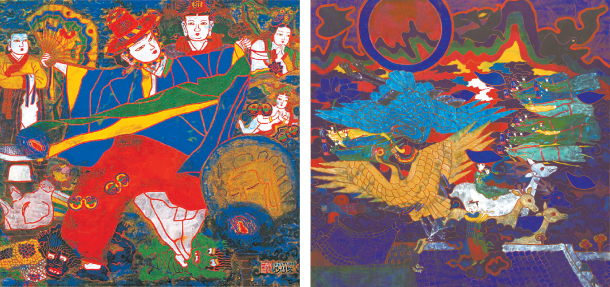Colorful art pioneer takes center stage in Daegu: Park Saeng Kwang inspired many of Korea’s minjung artists

Park Saeng Kwang’s paintings “Shaman 12”(1984), left, and “Sunset”(1979) are part of his retrospective at the Daegu Art Museum, which runs until Oct. 20. [DAEGU ART MUSEUM]
Seeing his most famous paintings, which depict mudang, or traditional Korean shamans, and Jeon Bong-jun, the leader of the 1894-95 Donghak Peasant Revolution, in bold colors and compositions, many viewers guess that Park must have been one of the artists that led the minjung art (people’s art) movement in the 1980s. In fact, Park, who was already in his 80s when the movement emerged, didn’t interact with the minjung artists, who were in their 30s and 40s at that time.
“However, Park greatly inspired the minjung artists,” Lee Jin-myung, chief curator of Daegu Museum, explained during a press briefing in Seoul on Monday about the museum’s new shows.
“His 1984 solo exhibition [at Fine Art Hall in Seoul] helped settle the minjung art movement,” Lee continued. “The younger artists obtained the confidence that they also can combine Western modernism and Korean traditional colored paintings [not black-and-white ink paintings], after seeing Park’s paintings.”
Park’s interest in Korean folk religions such as shamanism and folk Buddhism, as well as the history of the common people instead of that of the ruling class, were also in accordance with the interests of minjung artists, who were critical of Western-oriented modernization and Korean modern paintings such as dansaekhwa, which is a combination of Western abstract art and Korean ink paintings and calligraphy, which are a part of aristocratic tradition.
What is interesting is that Park’s paintings, which became the source of inspiration for minjung artists, were created when the artist was over 80.
“My father had already been interested in shamanism and folk religions in his 40s as the motifs of his art, but started actively experimenting when he got older,” said Park Jeong, the artist’s son, during the press briefing.
“This exhibition will feature many drawings of Park to help viewers know [about] Park’s experiments and evolution over a long time,” said Choi Eun-ju, the new director of Daegu Art Museum. She took the position in March after serving as the head of the Gyeonggi Museum of Modern Art.
Meanwhile, Daegu Art Museum also opened a solo show of painter and digital media artist Park Jong-kyu earlier this month.
And a large-scale group show about Korean pop art recently kicked off at the museum and runs through September. The exhibition, “POP/corn,” features more than 600 works by 14 well-known local contemporary artists including Lee Dongi, Noh Sangho, Im Jibin, Charles Jang and Artnom. The show also includes Kira Kim, who has seldom been categorized as a pop artist, but is famous for works of diverse media that satire capitalism and consumerism.
BY MOON SO-YOUNG [symoon@joongang.co.kr]
The “Park Saeng Kwang” exhibition runs through Oct. 20. Admission to the museum is 1,000 won ($0.89) for adults. The museum is closed on Mondays. For more information, visit http://artmuseum.daegu.go.kr










with the Korea JoongAng Daily
To write comments, please log in to one of the accounts.
Standards Board Policy (0/250자)